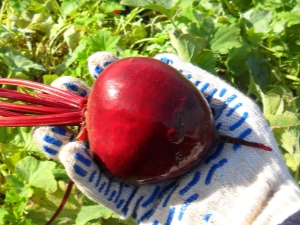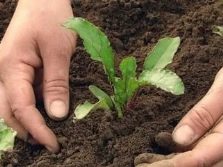Beet "Mulatto": description, planting and care

Ever since ancient times in Russia it has been popular to grow beets, or, as it is also called in some parts of our country, beetroot.This healthy vegetable is used everywhere in the preparation of dishes of Russian cuisine, being not only a tasteful decoration of the table, but also a healing product that gives the body health, as it contains many useful substances for it. This vitamin C, and calcium, and iron, and beta-carotene, and folic acid, and potassium.
One of several successful varieties for garden cultivation is the Mulatto variety. With the relative simplicity of cultivation, it gives a good harvest on our soils and in the climate of our country. This hybrid was actually bred and developed by domestic breeders in the late 80s for use in the realities of our country.
Characteristics of a variety
Unfortunately, even people who have been growing beets for many years do not always get a good harvest. Simply, there are some nuances regarding the growth of mulatka beets, and you need to take them into account when it is bred.
It is a mid-season variety that fully matures in up to 120 days. It is characterized by maroon fruits on the outside and red inside. Fruits are smooth, smooth, have a good round shape. The average weight is about 300 grams. The plant leaf is relatively low, has wavy oval green leaves with red veins.
This variety has a very high resistance to various plant diseases and temperature changes characteristic of our climate. And he is very unpretentious, and does not require much effort in their cultivation.
The maximum yield per hectare under all conditions of planting will be approximately 470 kg.
The main characteristic of the beet variety “Mulatto” is that this variety is very well stored in the winter period, not disappearing, in almost any storage conditions. According to many reviews, it is noted that even during the heat treatment of the fetus during cooking it retains most of the vitamins, nutrients and minerals needed by the human body. Also, the vegetable practically does not change its color in the cooking process, which also has a certain value for the appearance of the finished dishes.
Climatic zones
The use of this variety for cultivation in farms, gardens or homestead farms is recommended in the Central, Volga-Vyatka, Central Chernozem and Far Eastern regions of our country. Climate and soil, which are characteristic for them, are preferable for this vegetable.
Growing seedlings
The already sprouted beet seedlings of this variety are planted in the ground. Planting seeds directly into the ground is possible, but it does not give a big crop, besides growing time will grow for up to 25 days. And when planting seeds in the ground, it is necessary to subsequently carry out periodic thinning of vegetable sprouts.
Growing seedlings for planting is very simple.
- For seedlings need a soil of a certain composition, it is on sale. But you can make it yourself. Its composition: a mixture of half part of sand is made, with 1 part of ordinary earth, 2 parts of peat and 1 part of rotted compost or humus. And also 50 grams of wood ash must be added to each bucket of the mixture. Next, the result of mixing must be steamed in a double boiler for about 60 minutes.
It is possible and not to use steaming, if the soil is spilled already inside the cuvette, where the seedlings will rise, with solutions of the fungicide.
- In a deep cuvette, the layer of germinating mix is poured and leveled.
- Beet seeds are placed on top of it. It is advisable to use germinated seeds - this will give more chances for germination, especially since you can immediately screen the bad ones. Before planting the seeds, it is also desirable to process the fungicide and manganese - this will save the fruit from various diseases characteristic of this vegetable.
- Cover the seeds with a layer of the prepared mixture to a height of up to 1.5 centimeters and ram a bit so that the soil does not erode when it is spilled with water.
- Water, controlling, so that the seed does not surface.
- Transfer the finished cuvette with seeds to a well-lit and not cool place. Transferred, pre-covered it with a transparent bag, or glass. The optimum temperature balance for germination is + 18 ... 20 ° С.
- As soon as the first shoots appear, it is advisable to lower the air temperature to + 14 ... 16 ° С.
- When the first, cotyledon leaves appear, the plant dives, that is, in other words, they are transplanted from a small one into a large container. If a large and deep cuvette was originally used, then there is no need for a pick. If, however, a picking is used, then the soil for it is taken the same as for the initial seedling, but it is added to it in a tablespoon of nitroammofoski per bucket of the mixture. After picking it is necessary to shed seedlings. If the picking is not carried out, then when it is too thick seedlings it is thinned. Parts that have been removed are seated additionally.
- To prevent the stem from being pulled out a week after the picking, it is necessary to move the seedlings to the greenhouse, initially covering it from direct sun exposure.
- Every two weeks you need to feed the plant, which uses liquid fertilizer, containing in its composition nitrogen, phosphorus and potassium.
Planting seedlings in the ground
Planting seedlings in the soil carried out from the second half of April. Reading the reviews, you can see: many gardeners have noticed that it is enough for planting so that the soil warms up to + 10 ° С. As for the soil itself, this variety loves loose soil, in which the amount of sand is greater than the amount of clay. But also the soil should receive a sufficient amount of moisture and not have a high acid level. Seedlings are considered ready for planting when they already have real leaves.
So, what is needed for planting: for the beds on which the Mulatto will grow, a well-lit, sunny place is chosen. This is done so that even the slightest shade does not exist, as it will lead to a drop in yield. Land for planting should be rich in minerals, the variety loves highly fertile soil. In every square meter of soil make 40 grams of mineral fertilizers, which include nitrogen, potassium and phosphorus. Also, for each m², at least three kilograms of well-rotted compost or pure humus are applied.
If the soil is too acidic, then dolomite flour is added to it at 200 grams or wood ash at 400 grams per square meter. Following the beds are cultivated on the depth of the spade bayonet. This is done to ensure that the beet roots go quite deep into the ground.
Landing is made in cloudy weather, it is better even if it is a light rain. If the weather conditions for planting all the time are characterized by heat and dryness, then after planting you need to cover the seedlings with dense material for a couple of days until it takes root. The very same landing should be done in case of heat in the evening.
In the garden the wells are dug to such a depth that it is possible to put seedlings in them without kinking. The seedlings are respectively placed there, they wake up with earth and immediately watered. Also, watering is done daily until the seedlings are rooted and the weather is hot and dry.
After the rooting of the seedlings, the frequency of watering should be reduced, and the beets should be watered according to weather conditions. Too high soil moisture will lead to the development of such a disease in beets as scab. And with this disease stored vegetables will not be stored.
How to care?
The grade does not demand special care. The only thing you need is to periodically weed the plants and keep the earth in a loose state. And also it is necessary to produce vegetable feeding. For this, knowledgeable gardeners recommend using mullein, diluting it in proportions of 1 portion of mullein to 6 servings of water. This natural fertilizer contains in its composition minerals that are necessary for the production of large, juicy and sweet beet root crops.
Chemical fertilizers can also be used for fertilizing, but it must be remembered that at the beginning of the growth of the vegetable it needs nitrogen, therefore nitrogen fertilizers are used at the beginning of the plant's development. When the beet leaves converge, they transfer to fertilizing with fertilizers containing phosphorus and potassium.
Nitrogen is not needed at a later date - it begins to accumulate in the fetus in the form of nitrates.
There are several recommendations of agronomists regarding the cultivation of beets.
- In order to raise the level of sugar in the vegetable, it must be watered twice a season with a solution of salt (2 tablespoons per bucket of water) or a solution of sodium nitrate (1 tablespoon per bucket of water).
- To prevent the formation of voids and cork in the fruit, it is necessary to produce boric fertilizing of the plant several times per season. Top dressing should be done on the leaves of the plant themselves, and it should be done in cloudy weather, using a solution of two grams of boric acid per bucket of water.
Reviews
Reviews on the Mulatka beet variety are very positive both from the people who grow it and from the professionals of cooking. According to reviews, a vegetable of this variety is characterized by juicy, sweet pulp, it is beautifully stored and does not change its beneficial properties as a result of cooking or preservation. It is also noted that beet juice helps in the presence of hypertension, normalizing and leveling the pressure, and the use of the vegetable itself helps biological purification of the body from harmful slags.
Beetroot is used to prepare a variety of dishes ranging from borscht and ending with "herring under a fur coat." There are also dishes that are very good in taste and almost entirely consist of beetroot alone, for example, the vinaigrette.
In the next video you will clearly see the process of making beetroot salad.






































